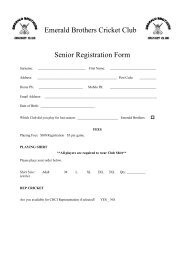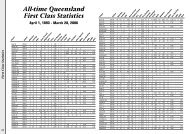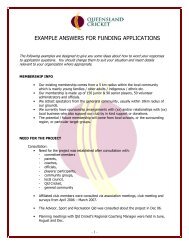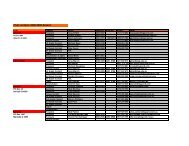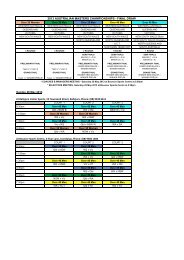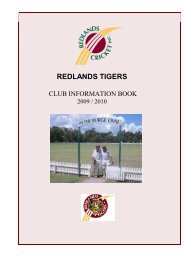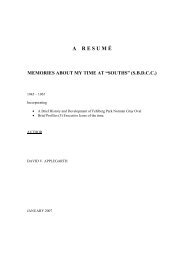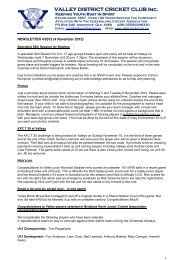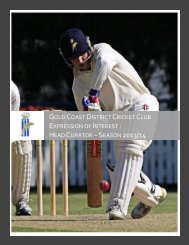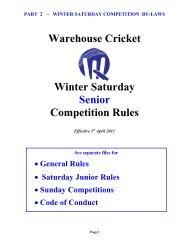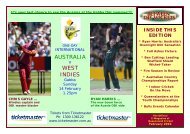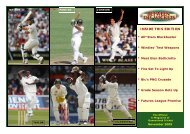the history of western suburbs district cricket club 1921-2002
the history of western suburbs district cricket club 1921-2002
the history of western suburbs district cricket club 1921-2002
You also want an ePaper? Increase the reach of your titles
YUMPU automatically turns print PDFs into web optimized ePapers that Google loves.
-38-Queensland in one domestic one day game and in being twelfth man in <strong>the</strong> losing 1989-90 SheffieldShield final.Brett played a major role in <strong>the</strong> premiership winning final <strong>of</strong> 1987-8, scoring fifties in both innings, <strong>the</strong>second whilst in great pain from a fractured knuckle. Fortunately, <strong>the</strong> pain disappeared with <strong>the</strong> victoryand <strong>the</strong> subsequent celebrations well into <strong>the</strong> night. Brett was a very hard hitting left hand batsmanwhose best shot was a l<strong>of</strong>ted drive. He was a handy medium pace bowler who could move <strong>the</strong> ball bothways at surprising speed at times. Brett was not one to take a backward step during on field verbalconfrontations and was always prepared to support a teammate.Ano<strong>the</strong>r bowling allrounder is chosen as number seven, Mark Thompson. Mark came to Wests in1987-8 having been NSW Under 19 Captain and quickly impressed, scoring 1380 runs at 20.29 and 127wickets at 27.52 between 1987-8 and 1995-6. Mark was an orthodox batsman whose strength lay indriving and a fast medium bowler who moved <strong>the</strong> ball both ways. He retired prematurely to join <strong>the</strong>business <strong>of</strong> his accountant friend, Jon Dooley, and to concentrate on family. Mark had received goodencouragement from his NSW forebear, Sam Trimble.Jon Dooley is <strong>the</strong> spinner in <strong>the</strong> team, taking 156 wickets at 32.56 between 1987 and 1999. He cameto Wests from Norths with Dean Tuckwell. John had two seasons at Colts and in 1993-4 became <strong>club</strong>captain, leading <strong>the</strong> team into <strong>the</strong> semi finals. He took 46 wickets at 16.58, to take <strong>the</strong> most wickets infirst grade that year (42 in fixture games). Whilst not being a big spinner <strong>of</strong> <strong>the</strong> ball, John deceivedbatsmen with subtle changes <strong>of</strong> flight. He was a very dogged batsman <strong>of</strong>ten leading by example andgoing in as night watchman where he took many blows to <strong>the</strong> body.John was an extremely inspiring and charismatic leader drawing <strong>the</strong> best out <strong>of</strong> his players and isnominated as captain <strong>of</strong> this team. John also played a significant role <strong>of</strong>f <strong>the</strong> field in roles as <strong>club</strong>treasurer and fund raiser. A succession <strong>of</strong> dinners he and o<strong>the</strong>rs organised helped <strong>club</strong> financesconsiderably and led to major improvements in <strong>club</strong> facilities.The WK in <strong>the</strong> team is Ray Phillips, who moved from NSW to Queensland and joined WSDCC in 1979-80 for <strong>the</strong> first <strong>of</strong> seven seasons. During this period, Ray played 78 matches for Queensland in whichhe scored 2618 runs at 28.96, caught 250 catches and effected 13 stumpings. Ray was a talkative,efficient WK and a busy batsman. The highlight <strong>of</strong> his career was <strong>the</strong> Ashes Tour <strong>of</strong> 1985, and at a <strong>club</strong>level <strong>the</strong> 1980-1 grand final.Peter Donaldson’s partner in arms, John Bourke is <strong>the</strong> next player chosen. John was extremelyaccurate, could bowl all day and was <strong>the</strong> perfect foil to <strong>the</strong> faster Peter. Wests were very fortunate whenJohn moved across from Valleys to give seven seasons <strong>of</strong> sterling service in which he took 255 wicketsat 20.64.Ano<strong>the</strong>r left armer Nick Belous also makes <strong>the</strong> team as twelfth man. Off only a five pace run up Nickdeveloped surprising speed. He was very accurate and just did enough with <strong>the</strong> ball to take 225 wicketsat 20.53 in his nine first grade seasons. Due to injury he dropped down to captain third grade in his latterseasons where he played mainly as a batsman, but on <strong>the</strong> rare occasions he bowled, he surprised thirdgrade batsman with his pace and movement.Number eleven in any team he played went to Carl Grey Rackemann, a Queensland sporting icon. Itwas Carl who in 1984-5 wept tears <strong>of</strong> despair when playing in a losing Sheffield Shield final in Sydneybut it was also Carl who caught <strong>the</strong> winning catch at <strong>the</strong> Gabba in 1994-5 and on this occasion <strong>the</strong>y weretears <strong>of</strong> joy. He has <strong>the</strong> third highest number <strong>of</strong> wickets in interstate <strong>cricket</strong> with 383 at 26.32 in his 102matches for Queensland and in his 12 matches took 39 wickets at 29.15 for Australia. But for injury and<strong>the</strong> decision to tour on <strong>the</strong> rebel South African Tour (to financially support <strong>the</strong> family property) at a timewhen he was at his <strong>cricket</strong>ing peak, Carl would have taken many more wickets for Australia. Howeverhis heart lay with Queensland and he was suitably rewarded with a Contiki tour <strong>of</strong> <strong>the</strong> West Indies in1995. A season with Surrey in 1995 probably shortened his career for Queensland in that he wasdropped <strong>the</strong> following season after three poor games. Carl played a single game for WSDCC taking 1for 45 from 10 overs in 1996-7 but did not play for <strong>the</strong> <strong>club</strong> again despite some talk about recruiting himfor <strong>the</strong> three peat fifth grade team <strong>of</strong> 1997-8. Carl is <strong>the</strong> only player in <strong>the</strong> <strong>history</strong> <strong>of</strong> <strong>cricket</strong> to have notannounced his retirement, and still had not by 2001-2. In <strong>the</strong> meantime he has been a television andradio commentator, <strong>the</strong> Zimbabwe coach, a Queensland Cricket Ambassador, a businessman withBeaurepaires and a farmer. Only occasionally were <strong>the</strong> wickets in grade <strong>cricket</strong> (from Wynnum Manlyvia Sandgate Redcliffe) to Carl’s liking, but this usually coincided with matches against South Brisbane.On one memorable occasion he took 10 wickets in a match at Graceville winning <strong>the</strong> match for Westsoutright. Of his 16 years in grade <strong>cricket</strong> Carl played 10 <strong>of</strong> <strong>the</strong>m with Wests and had good support fromhis sister Helen and bro<strong>the</strong>r in law, Malcolm Gold, who played for Wests from 1988-9 to 2000-1.The highlight <strong>of</strong> Carl’s batting career was <strong>the</strong> scoring <strong>of</strong> <strong>the</strong> slowest duck in test <strong>history</strong> in <strong>the</strong> SydneyAshes Test match <strong>of</strong> 1990-1 series which turned out to be his last test match. This led to Australia saving<strong>the</strong> match. The Queensland highlight was <strong>the</strong> score <strong>of</strong> 33 against Tasmania in Hobart. The low light <strong>of</strong>Carl’s grade career was his declaring <strong>the</strong> Wests innings closed at 6 for 26, against Easts in 1992-3, morethan 100 runs behind <strong>the</strong> opposition, and allowing <strong>the</strong>m to reinsert. However two o<strong>the</strong>r senior playersin <strong>the</strong> team on <strong>the</strong> day did not disagree with <strong>the</strong> decision.If a fieldsman were to be selected during this era as twelfth man it would be Tony Taylor who was amagnificent ground fielder. Tony was an excellent batsman as well who played first grade for <strong>the</strong> <strong>club</strong>in 1981-2 and in <strong>the</strong> next six seasons apart from a stint with a colts team which included Ian Healy,scored 1523 runs at 27.19 with a heartbreaking highest score <strong>of</strong> 97 not out. Whilst practising oneevening at Graceville Tony suffered a fractured skull in a freak accident when a ball bounced upawkwardly on its return to his bowling, hitting him in <strong>the</strong> forehead. He later required surgery.In <strong>the</strong> late 1990's Tony returned to <strong>the</strong> <strong>club</strong> after many years away teaching in <strong>the</strong> country, to play anumber <strong>of</strong> seasons <strong>of</strong> third grade. At this time he graduated in law to practice at <strong>the</strong> bar. Thus hefollowed in <strong>the</strong> footsteps <strong>of</strong> three o<strong>the</strong>r Wests old boys, Ian Callinan, Tom Shepherdson and Garry



